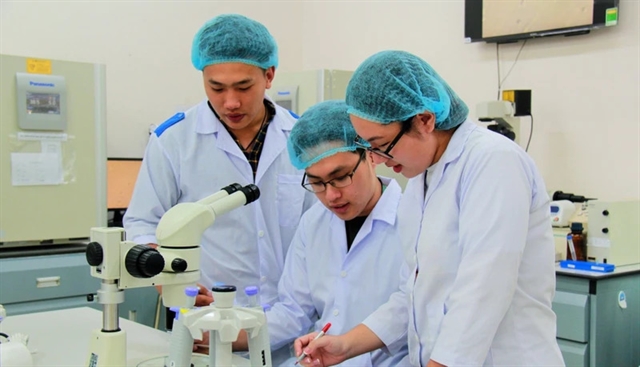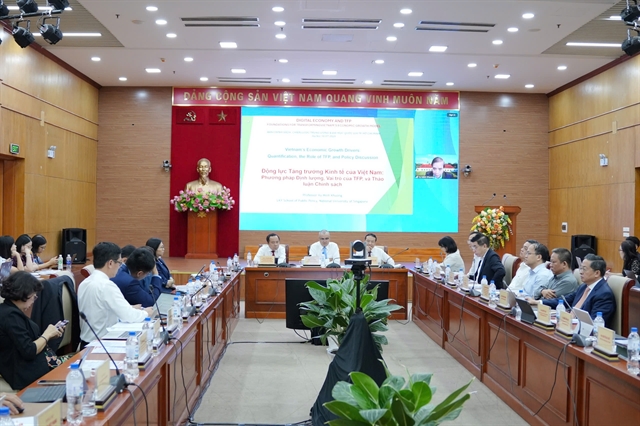 Society
Society


|
| Scientific research at the Việt Nam National University-HCM City. — Photo Courtesy of VNU-HCM |
HÀ NỘI — Raising total factor productivity (TFP) is essential for Việt Nam to sustain high economic growth and achieve high-income status by 2045, experts said at a seminar held in Hà Nội on July 10.
The seminar, called “Digital Economy and TFP: Foundations for Reforming Việt Nam’s Economic Growth Model,” brought together leading scholars and policymakers to discuss long-term drivers of growth.
Professor Vũ Minh Khương from the Lee Kuan Yew School of Public Policy at National University of Singapore said Việt Nam has set ambitious growth targets – eight per cent or more this year, double-digit growth in the coming years, and high-income status by 2045.
He outlined two scenarios for achieving this goal. In the first, per capita GDP grows by 5.5 per cent annually, reaching US$11,000 by 2045, similar to Malaysia’s income level in 2021.
In the second, Việt Nam maintains annual per capita GDP growth of 6.5 per cent over two decades, reaching $15,000 by 2045 and potentially $20,000 by 2050.
“To do so, Việt Nam must improve its TFP, which is currently lower than that of high-income countries. Việt Nam needs to shift to a new growth trajectory.”
TFP is a key metric that measures how efficiently and effectively inputs are turned into outputs and is often used to gauge the contribution of innovation, technology, and management practices to economic performance.
Agreeing with this perspective, Professor Tan Swee Liang from the Singapore Management University, said once capital and labour inputs are maximised, only productivity gains can drive further growth.
“That’s why TFP is the key engine of long-term economic development,” she said.
Digital transformation is expected to play a vital role in raising TFP by enhancing research and development (R&D), reducing costs, and improving governance.
Automation, big data analytics, the Internet of Things (IoT), and artificial intelligence (AI) can optimise production processes and generate added value.
According to the Politburo’s Resolution No.57 on science, technology, innovation and digital transformation, Việt Nam aims for TFP to contribute more than 55 per cent of GDP growth by 2030.
The share of high-tech exports is targeted at a minimum of 50 per cent, and the digital economy is expected to reach at least 30 per cent of GDP, with a vision of 50 per cent by 2045.
A report by a research group from the Việt Nam National University-HCM City (VNU-HCM) affirmed that TFP is the primary driver of long-term GDP growth.
Countries like the US, South Korea, and Germany have succeeded through ‘deep growth’ based on innovation, R&D, and high technology.
By contrast, developing countries such as India, Indonesia, the Philippines, and Việt Nam still largely rely on capital, cheap labour, and structural shifts.
As a result, TFP growth has been slow and inconsistent due to constraints in infrastructure, institutions, and technological innovation, a combination that leaves countries vulnerable to the so-called ‘middle-income trap’.
In Việt Nam, TFP contributed just 30-35 per cent to GDP growth between 2010 and 2020, significantly below the OECD average of over 50 per cent.
“This shows the urgent need for institutional reform, increased R&D investment, better education, and digital transformation to ensure sustainable growth,” the research group noted.
To enhance TFP, Professor Khương said Việt Nam must overhaul its management strategies at all levels – from central to local government - and restructure its development model away from resource-driven growth.
“We need to prioritise innovation, improve human capital, and invest heavily in technology,” he said, adding that a national fund should be created to help small and medium-sized enterprises acquire foreign technologies.

|
| A seminar held in Hà Nội on July 10 brought together leading scholars and policymakers to discuss long-term drivers of growth. — Photo Courtesy of VNU-HCM |
Dr Nguyễn Quang Vinh, an expert at the World Bank, said innovative startups are essential to shifting from low- to high-productivity sectors.
However, a recent World Bank survey showed that only a small percentage of Vietnamese businesses surpass the average in innovation.
Around 80 per cent of firms only improve internal processes without introducing new value to the market.
Moreover, Việt Nam currently spends only 0.5 per cent of GDP on R&D, far below its 2 per cent target.
“Việt Nam must scale up technology diffusion and encourage private investment in R&D to break out of the middle-income trap,” Vinh said.
Experts also emphasised the need for a comprehensive innovation ecosystem that tightly links the government, scientists, and enterprises.
Strengthening digital infrastructure and promoting digital transformation in education, healthcare, finance, logistics, and public administration will be critical.
From a policy perspective, Phạm Đại Dương, deputy head of the Central Economic Commission’s Strategy and Policy Division, underlined the importance of TFP in assessing economic productivity and efficiency.
“However, the government must adopt a unified methodology for calculating TFP to ensure accurate policy-making,” he said.
The Central Economic Commission will continue gathering input from experts, scientists, and agencies to refine Việt Nam’s approach to measuring and improving TFP and advancing the digital economy, he added. — VNS




